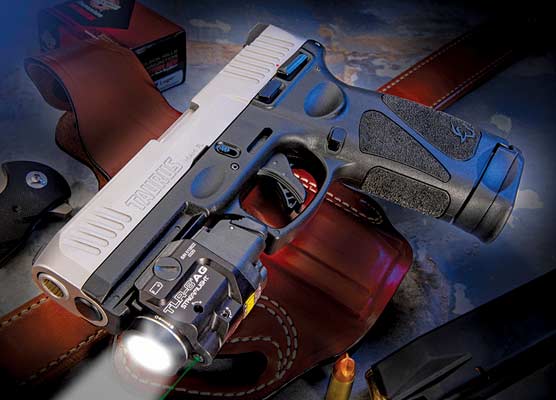| Better Shooting |
0
By Dave Anderson
The key to better shooting skills is disciplined, diligent training. In this era of instant gratification I can understand how many are looking for shortcuts, some magic tip to make it all easy. Well, there aren’t any. Along the way are many traps and excuses. I don’t have time/don’t have a place to shoot/can’t afford it, and so forth. A common one is to get caught up in trying to buy skill — if I only had this gun/holster/sight/good luck charm!
A few years ago while visiting Rob Leatham, I borrowed Rob’s #2 match pistol for a local match. Darn it, even with a world champion’s pistol I didn’t win. Hard to believe, I know. Actually, I did pretty good, around 15th as I recall. Leatham won, but of course he had his #1 match pistol. If only we had switched.
Now I’ll change sides and say some things do matter. Shooting is an equipment-based activity. I think we would all agree a firearm must be safe and serviceable. I’d rate reliability second in importance, behind only safety. Next in importance is a quality trigger pull.
A good trigger isn’t necessarily light. It’s consistent and relatively smooth, without perceptible “steps” during the release. A bit of “take-up” or trigger slack is normal in an autopistol. Likewise I can accept a small amount of trigger overtravel, or movement after the sear releases. I don’t consider excessive overtravel desirable, but taking out all overtravel raises reliability concerns. A bit of dirt buildup, or a trigger stop moving or expanding from heat, may result in the sear not releasing at all.
Forty years ago, there weren’t a lot of gunsmiths offering quality trigger work on 1911s. There are more today, and certainly more choices of quality components, such as hammers and sears built to close tolerances and with hardened contact surfaces. If you want a pull between, say 3 to 3.5 pounds, it isn’t all that hard to achieve. Frankly the exact weight doesn’t matter much as long as it’s consistent. For example if I ask for a 2.5-pound pull and it comes out at 2.75 pounds, I don’t mind, provided it doesn’t vary more than an ounce or so either way.
QuickShot 48 and 5-shot draw targets put the fun into plinking, though don’t be
surprised if the competition gets serious. Always glad of a chance to get out the
matched set of circa 1950 S&W K-22 Masterpiece revolvers.
But to find out who really walks-the-walk, ask for a specific weight and see how close it comes. A buddy shoots a Springfield Armory Range Officer, a model I consider an outstanding value in a 1911. Being a veteran PPC competitor he is a trigger fussbudget. He sent the Springfield to Terry Tussey asking for a 3-pound pull. Tussey is one of the few real masters of the 1911 trigger.
Tested with a Lyman trigger gauge, a 20-test average came in at 2 pounds, 15.6 ounces. Not exactly 3 pounds? Well, the difference could be my gauge or my measuring technique. More importantly, weight of pull varied by only about an ounce at most.
Weight aside, quality of pull is exceptional. There’s about 1/16″ of smooth take-up, a crisp and virtually motionless break, and barely perceptible overtravel. My buddy couldn’t be more pleased with the work. He shoots a lot and dry-fires even more, but so far the pull hasn’t changed, and I’m sure it will prove durable. Great work from a man who truly understands the 1911. Standard 1911 trigger jobs run $189, Series 80 Colts are $219, Taurus/Beretta pistols $199.
Terry Tussey was asked to tune the trigger of this
Springfield Armory Range Officer to a 3-pound pull.
One of the more pleasant ways to spend a lazy summer afternoon is sitting on the deck with a cooler of iced soft drinks and enjoying some informal target shooting. It helps if the deck is out in the country, with a safe backstop and no nearby neighbors. If you’re getting jaded with tin cans and standard targets, consider a couple of options from Quick Shot Targets. The Quick 48 target has 48 numbered sections. One game is to draw a number at random, then alternate shots and see who hits the chosen number first.
Another is to take turns firing 5-shot strings and see who gets the highest total score. Or see who can shoot the highest score in five seconds, or 20 seconds. Or see who is first to 150 or 250. Or — make up your own game. The 5-shot draw target can likewise be used for any number of card games, either with just the target, or in combination with an actual deck of cards. For example each player could be dealt two cards, then fire three shots to try and improve the hand. I’m sure poker enthusiasts can come up with more and better ideas.
The targets are big at 20″x28″, colorful, and printed on heavy stock. Basic packages are 12 targets for $19.95, with discounts for larger orders (36 for $39.95, 60 for $64.95). Tape the bullet holes as you go and each target should easily last a full afternoon of shooting. Good clean fun and no tin cans to pick up!
For more info: www.americanhandgunner.com/tussey-custom, (775) 246-1533;
www.americanhandgunner.com/quickshot-targets, (847) 439-5200
Read More Better Shooting Articles
Download A PDF Of The American Handgunner Nov/Dec 2013 Issue Now!


